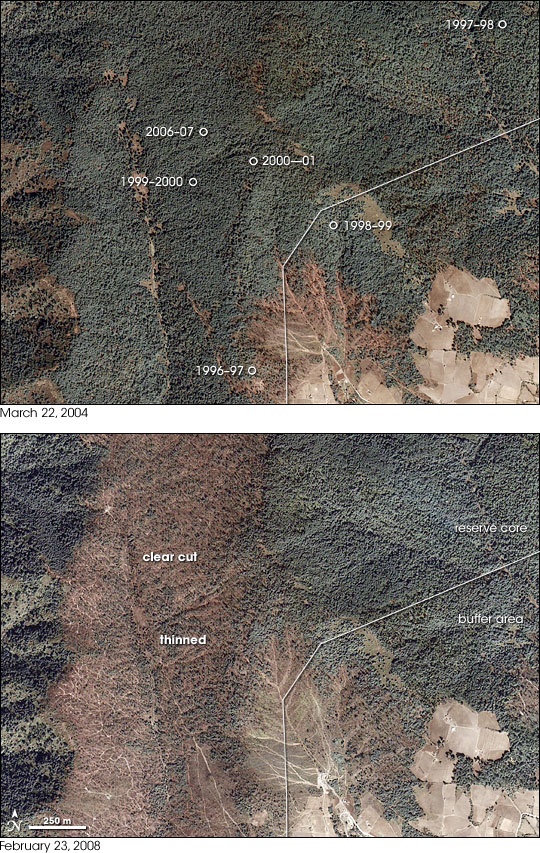


Each year millions of monarch butterflies migrate thousands of miles back and forth from wintering grounds in Mexico to their breeding locations in the eastern United States and Canada. In the fall, the monarchs return to just 12 forested mountaintops in central Mexico, where they form colonies in which millions of butterflies cluster on the trunks and branches of the trees. Despite the creation of protected areas and reserves, illegal logging has been steadily shrinking this unique, critical monarch habitat.
Recently, scientists identified severe degradation of the forest habitat within the Monarch Butterfly Biosphere Reserve in central Mexico using imagery from the commercial Ikonos satellite. The white line indicates the boundaries of the reserve’s “Core Zone,” where logging is forbidden according to the Presidential decree that established the reserve in November 2000. This pair of images shows the affected area on March 22, 2004 (top) and February 23, 2008 (below). The degraded area is the site of the Lomas de Aparicio monarch colony. The circles on the image (not to scale) indicate the approximate positions of the colony in different seasons. Colonies typically cover areas of 0.25–2.0 hectares (equivalent to a circle with a diameter of 60–160 meters, or 200–525 feet). The area had been largely intact since at least 1986. Overwintering colonies have been documented there since 1996, but have probably formed there long into the past.
In the 2004 image, the beginnings of the logging operation are apparent in an area to the east of (and partially inside) the core zone. Based upon this pair of images, and a similar image taken in 2006 by the QuickBird satellite, scientists Lincoln Brower, Daniel Slayback, and Isabel Ramirez have determined that approximately 450 hectares (1,110 acres) of forest were logged between 2004 and 2008, representing 3.3% of the 13,552 hectares (33,410 acres) core zone of the reserve. The majority of this logging (290 hectares, or 717 acres) has occurred since March 2006.
Forest degradation—which progresses from thinning to clear-cutting—has been an ongoing problem throughout the reserve. Other logging incursions have destroyed several other prime overwintering areas within the reserve, making them unsuitable for monarch colonies. Based upon the degradation apparent in these images, it is unlikely monarchs will form overwintering colonies at this Lomas de Aparicio site in future years. If they do return, they will be subject to much greater environmental risks during their six-month overwintering stay. An intact forest canopy serves a critical role by protecting the monarchs from both freezing cold during winter storms and from excessive warmth during the days. If unprotected from the sun, monarchs dehydrate and also risk starvation: they burn substantially more of their fat reserves when they can’t keep cool.
The researchers are greatly concerned that the entire monarch butterfly migration and overwintering phenomenon in eastern North America may collapse in the near future if the Mexican government does not fully enforce the logging ban.
Images by Robert Simmon and Daniel Slayback, based on data © GeoEye. Interpretation and analysis provided by Lincoln Brower, Sweet Briar College, Sweet Briar, Virginia; Daniel Slayback, Science Systems and Applications, Inc., Lanham, MD; and Isabel Ramirez, Centro de Investigaciones en Geografía Ambiental, Universidad Nacional Autónoma de México.
© All Rights Reserved: Use of IKONOS, GeoEye, QuickBird and WorldView imagery must be coordinated with Maxar.